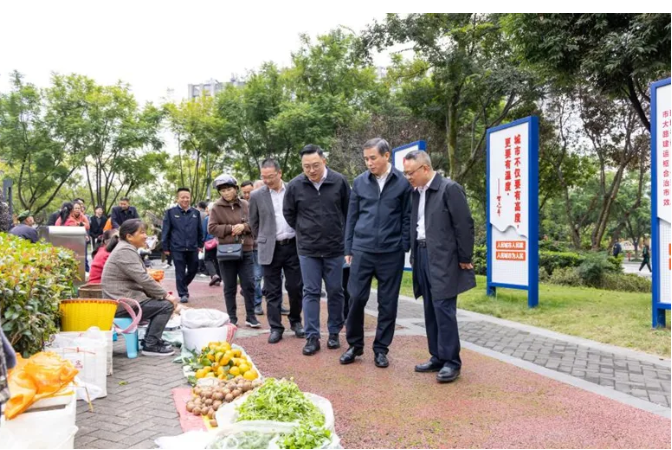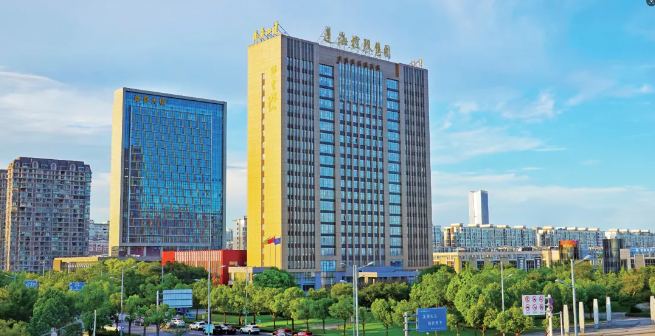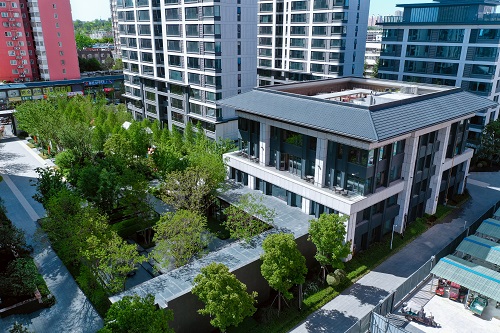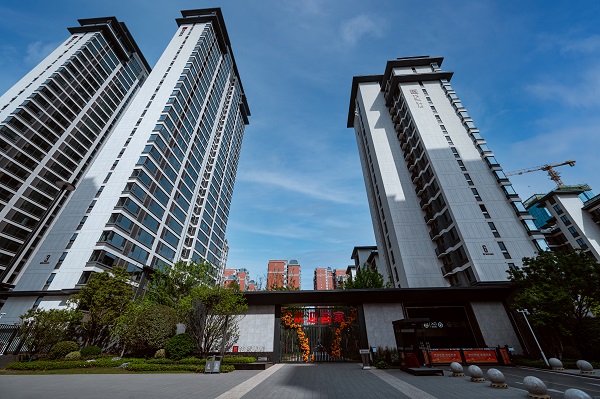鉴于学生人数不断增长,以及对教学空间的需求增加,一个新型跨学科教学大楼由领先学府荷兰代尔夫特理工大学率先打造,满足当前和未来更多灵活教学空间的需求。
In light of ever-increasing student numbers, combined with the need for more education space, the new inter-faculty building for TU Delft is designed to meet the leading Dutch university’s need for flexible extra teaching space – now and in the future.
能源再生型绿色建筑:Echo教学大楼产生的能源大于运行期间的耗能
Energy-generating building: Echo will harvest more energy than it uses during operation
跨学科的教学大楼:多种适应性强的教学空间,最大限度地提高了空间布局的灵活性
Interfaculty building: wide variety of adaptable teaching and study spaces for maximum flexibility in scheduling
以健康为核心:Echo教学大楼的设计旨在促进使用者的身体、心理和社会健康
Health-focused: Echo is designed to promote physical, psychological and social health
超前的教学环境:为新型学习方式和未来校园建筑树立典范
Transcends current learning environments: a model for new ways of learning and for future campus buildings
Echo是一座新型跨学科的产能教学大楼,内设各类教室,适应多样的教学方法和学习方式。作为荷兰代尔夫特理工大学最具可持续性的建筑,Echo教学大楼助力学校在2030年整体实现可持续校园的愿景。
Echo is an energy-generating interfaculty building that offers a wide variety of teaching rooms to cater for the diversity of teaching methods and study styles at the university. As the most sustainable building at the TU Delft, Echo is contributing to the university’s ambitions to operate a fully sustainable campus by 2030.
Ben van Berkel (UNStudio创始人/首席建筑师) :“Echo是一个校园建筑的典范。在这座高度紧凑的建筑中,空间的利用扩展至极,不同学科背景的学生实现了更紧密地联系。在这里,他们不仅可以分享彼此的学习经验并相互学习,还可以从建筑本身中获取知识。”
Ben van Berkel (Founder/Principal Architect UNStudio): The Echo building teaches by example. In this highly compact building, the use of space is maximised, while bringing students from different disciplines in closer contact. Not only can they condense their learning experience and learn from each other, but they can also learn from the building itself.”
*充分利用空间:建筑过渡空间合理化利用,增多使用者之间的会面与互动。
Making the most of space: the in-between spaces at Echo are carefully considered to encourage meeting.
©Photo by Evabloem
新的前瞻性教学大楼Echo ,由UNStudio与 Arup 和 BBN 联合设计,以适应性和使用者的健康为核心,融合产能绿色理念,打造全力支持多种教学方法和形式的教学大楼。
For Echo, UNStudio, in collaboration with Arup and BBN, created a design that fully supports different educational typologies and teaching methods with an energy-generating building in which adaptability and the wellbeing of the user are central.
Ben van Berkel:“与传统校园有所不同,未来的校园需要规划灵活多用的空间,鼓励学生和教师展开学习、共同合作和创造。随着学生人数不断增长,教学建筑需要具备高度的灵活性,通过建立一种跨学科共享使用的模式来运作,以促进更全面的学科教育。
Ben van Berkel: “Unlike traditional campuses that operate in silos, the future campus needs to be programmed with agile spaces that invite students and faculty to learn, collaborate and co-create. As student numbers continue to grow, educational buildings need to be extremely flexible, to operate through a model based on shared interfaculty use that can promote a more generalist education.”
*Echo教学大楼的透明性、公共性和开放性
Transparency, publicness and openness of Echo
©Photo by Evabloem
*屋顶太阳能电池板装置
1200 solar panels are installed on the roof
©Photo by Evabloem
*建筑剖面图
Section ©UNStudio
1200块太阳能电池板、智能装置、良好的绝缘材料和冷热库系统的应用确保Echo教学大楼在供应日常运行所需的能源的同时还有所结余。这其中包括了供应使用者所需的能源,如笔记本电脑、照明和餐饮的电力消耗。另外,建筑中90%的家具都是可重复利用的。
1200 solar panels, smart installations, good insulation and a heat and cold storage system ensure that Echo will be able to provide more energy than it requires for its daily operations. This includes user-related energy, such as electricity consumption for laptops, lighting and catering. 90% of the furniture used in the building has also been reused.
*呈现最大限度采光、明亮和令人振奋的教学空间,并连接了校园两侧。
A full of daylight, bright and uplifting environment, also creates a visual connection
©photo by Hufton+Crow
Echo教学大楼在设计时还有一个十分重要的考量因素-透明度。它不仅确保了建筑体内最大限度的采光(众所周知,这有益于使用者的身体健康,并减少了对人工照明的需求),同时创造了与整个校园和周围自然环境的视觉延伸感。因此,有效避免了封闭式教学体验感,而建筑的开放性和公共性将其向校园两端延伸拓展,为师生提供了一个明亮、令人振奋和友好的教学环境。
Transparency was essential to the design of Echo. It not only ensures maximum daylight inside the building (known to have health benefits for the users, but also reducing the need for artificial lighting), it also creates a visual connection to the wider campus and to surrounding nature. As such, a closed-in, ‘institutional’ experience for the users is avoided, while the open and public character of the building connects the two sides of the campus and provides a bright, uplifting and welcoming environment for faculty and students alike.
*悬挑的深型水平铝制遮阳篷阻挡了多余的日光照射,藤曼形成绿色幕墙
The deep horizontal aluminum awnings keep out excess solar heat, green facade
©photo by Hufton+Crow
然而,为了避免建筑渗入过多热能,需要阻隔阳光的过度穿透。通过玻璃的防晒性和低太阳能渗透性的结合应用,可以有效的解决这一问题。除此之外,悬挑的深型水平铝制遮阳篷的应用也有效阻挡了多余的太阳能热量。遮阳棚通过线缆相互连接,绿植沿着线缆蔓延,又巧妙的形成了一个绿色幕墙,进一步过滤日光照射。
However, to avoid heat gain, it is also essential to prevent excess sunlight penetration. Overheating of the building is prevented by a combination of sun protection and the low solar penetration factor of the glass. In addition, the deep horizontal aluminum awnings keep out excess solar heat. These canopies are interconnected by cables along which climbing plants form a subtle green facade that filters daylight.
*图表解析-楼内新鲜空气输送系统
Diagram ©UNStudio
为确保大楼内空气清洁,我们在空心楼板上方设置了架高地板。新鲜空气即是从下而上由地面输送,而不是从上向下送风,这个措施避免了新风在空间内周而循环。为了适应未来空间布局发生的变化,该系统的通风口以及计算机地板装置可以很容易地重新进行移位。
To ensure clean air in the building, a plenum floor is installed above hollow-core slabs. Here fresh air is pumped up from the floor, rather than down from above, thus avoiding circulation around the room. The vents for this system, along with the computer floor installation, can easily be relocated, should the layouts of the rooms change in the future.
*图表解析图-前瞻性绿色建筑
Diagram ©UNStudio
在设计时,不仅注重施工材料对环境产生的影响,也使建筑的设计尽量遵循大楼内部自循环系统原则。设计采用大尺寸网格形成宽敞入口,立柱沿着建筑空间边缘设置,从而打造大跨度的无柱开放空间。钢桁架采用标准尺寸,以便于拆卸,即使大楼超过使用年限后,这些部件仍然可以被再次利用到其他地方。空心板将来也可以重复使用。
Not only has a great deal of attention been paid to the environmental impact of the materials used in the construction, but the building has been designed as much as possible according to principles of circularity. Using large portal constructions with large grid sizes, the columns run along the edge of the building, creating column-free spaces with large spans. The steel trusses have standard sizes and can be dismantled so that they can be reused elsewhere after the lifespan of the building. The hollow-core slabs can also be reused in the future.
*教学楼内室内空间,中央大楼梯一瞥
Interior ©Photo by Evabloem
新设计的Echo教学楼具有灵活多功能的空间和超前的教学环境。当代“一应俱全”的文化理念贯穿于整个设计之中,凸显过渡空间的重要性,同时也促进了更多的走动和会面。因此,Echo教学大楼也为使用者安排碎片时间提供了空间地点:用于人们反思思考、灵感激发和互动交流的多样化平台。
Echo is an education building with multifunctional spaces that transcends current learning environments. The design supports the contemporary culture of 'Everything Anywhere', where the in-between spaces are also of great importance and physical movement is stimulated. Echo therefore also provides space for unstructured time: a variety of platforms for reflection, inspiration and communication.
*上图:灵活多功能的空间和超前的教学环境
Transcendscurrent learning environments
下图:设计展现过渡空间的有效利用,用于人们反思思考、灵感激发和互动交流的多样化平台。
Spacefor unstructured time: avariety of platforms for reflection, inspiration and communication.
©Photos by Evableom
*图表解析 Diagram
上图:室内空间分布
Interior layout
中图:条状竹材沿天花板延伸
Bamboo ribs extend along the ceiling
下图:条状柱饰延伸至中央楼梯,连接学习和互动空间。
Bamboo extended around the central staircase
©UNStudio
大楼的室内设计旨在为到访者营造出温馨友好的氛围。在特定位置,条状竹材沿天花板延伸,构成精妙设计的一部分。雕工精致具有质感的竹材一直延伸到中央楼梯,将学习和互动空间流畅的连接在一起,构成学习、协作和创建连接的互联世界。中央“大楼梯”的设计,为使用者创造楼内走动的机会,有利于学生、研究人员和教师们的身体健康。
The interior offers a warm welcome to visitors. At specific positions, bamboo ribs extend along the ceiling, forming an integral part of the design. The crafted look and feel of the bamboo is extended around the central staircase, that in one gesture joins the study and cooperation spaces into one connected world of learning, collaboration and connection. This centrally positioned 'grand stair' facilitates and promotes physical movement through the building and thus contributes to the health of students, researchers and teachers alike.
*室内空间-中央楼梯及大楼底层的透明区域
Interior-Central staircase and transparent ground floor
上图:©photo by Evabloem
下图:©photo by Hufton+Crow
前瞻性校园一定具备生机勃勃、充满活力的特性。这体现了Echo的设计愿景,不仅与周围公共空间联通且相辅相成,又创造了崭新的面貌。相邻的广场通过大楼底层的透明区域,与另一侧的街道相连,将Echo的透明底楼变成一个有顶的公共广场和公共连接设施,使无形的学习氛围转变为一种可见且迷人的体验。
A future-proof campus is an active campus. That is why Echo not only connects with the surrounding public space, it also defines it. The adjacent square continues through the transparent ground floor of the building and connects with the street on the other side, turning the ground floor of Echo into a covered public square and a public connector that makes the invisible world of learning a visible and engaging experience.
*两个具有雕塑感的空间呈对角线布局
Two sculptural volumes simultaneously defines two large transparent corners
上图:互动的、吸引人流的空间布局 Diagram
中图:辩论空间 Debate space
下图:容纳700人的大讲堂 The large 700 person lecture
©photo by Evabloem
楼内两个有雕塑感的空间,一个容纳700 人的大讲堂和一个辩论空间,将人流吸引至这个有顶的公共广场。这两个设计精妙的空间呈对角线分布,同时也定义了两个透明转角区域,其中一个为带有露台的餐厅,正位于Dreamhall的对面;另一个是宽敞的景观学习区。
Two sculptural volumes (the large 700 person lecture hall and the debate space), direct the flow of people across this covered square. The diagonal orientation of these volumes simultaneously defines two large transparent corners, one housing a restaurant with terrace opposite the D:Dreamhall, and the other a large study landscape.
*景观学习区
A large study landscape ©Photo by Hufton+Crow
建筑面积8844平方米的Echo大楼内设置了大讲堂、教室和各类学习空间,可为大约1700名学生提供讲座和辅导、小组活动、项目教学、辩论和自学空间。
The 8,844 m2 Echo building provides space for lectures and tutorials, group work, project-based teaching, debates and self-study for around 1,700 students by way of the lecture rooms, classrooms and a variety of study spaces.
*大讲堂空间设计
Interior-Thelargest lecture room
©Photo by Evabloem
Echo教学大楼共有七间教室,大部分可进行灵活布局。位于一楼面积最大的大讲堂可容纳700人,并且可以在15分钟内移动为三个独立的空间。因此,多个讲座或活动可以在不同空间同时进行,并最大限度地对激发空间的灵活布局可能。
Echo houses a total of seven teaching rooms, most with a flexible layout. The largest lecture room on the ground floor, which can accommodate 700 people, can be divided into three separate rooms in 15 minutes. This enables multiple lectures or events to take place simultaneously and enables maximum programming of the space.
*具备活动墙系统的多形式教学空间
Mixed didactic space with a movable wall system
©Photo by Evabloem
位于一楼的多形式教学空间中应用了类似的活动墙系统,可以在需要时将其分隔为两个各容纳144个座位的教室。此外,整个大楼里还有300多个学习空间可用于小组活动和自学。
A similar movable wall system is used in the mixed didactic space on the first level, so that this can be divided into two classrooms of 144 places each when required. The more than 300 study spaces throughout the building can be used for group work and self-study.
*上图:教学大楼剖面图 Section
下图:室内空间布局图 Interior layout
©UNStudio
所有教室均根据师生当前和未来需求而设计。Echo教学大楼侧重于可容纳150人至700人的中大型教室。除了这些大型教室外,楼内还设置了一个案例研究教室,尤其适合于教师和学生之间进行激励型教学和互动。此外,还有四个用于项目教学的标准教室,每间可容纳近 70 人。
The various teaching rooms have been designed based on the current and future needs of the lecturers and students. In Echo, the focus is on medium-sized and large teaching rooms, accommodating between 150 and 700 people. In addition to these larger rooms, there is also a case-study room that is particularly suitable for motivational teaching/interaction between lecturers and students. In addition there are four level rooms for project-based teaching, each accommodating almost 70 people.
位于二楼的办公空间应用了模块化的墙体系统,为未来灵活变化的布局提供可能。如果未来有功能变化需求,这些办公空间可轻微移动转变为教学空间。
A modular wall system has been used in the office spaces on the second floor, allowing for future changes to the layout. Should there be demand for functional change in the future, these office spaces can be turned into didactic spaces with minimum interruption.





发表评论 取消回复